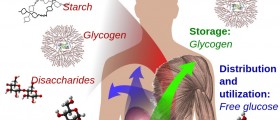
Diabetes or diabetes mellitus, effects people worldwide. It is a condition marked by the increased level of glucose in the blood, which happens due to certain problems with the hormone insulin. Diabetes mellitus can be classified into three types: type 1 diabetes, type 2 diabetes and gestational diabetes or diabetes in pregnancy. All three types of diabetes have very much the same symptoms and consequences although the cause for their occurrence is not the same. Therefore, the pathophysiology of diabetes mellitus is very complex.
Diabetes mellitus and pathophysiology
The hormone insulin is responsible for regulation of the level of glucose in the blood. The beta cells of the pancreas produce this hormone. Insulin assists the glucose to enter the cells and then, the cells use sugar as the main source of energy.
Nevertheless, when one suffers from diabetes, the body cells do not use enough of glucose form the blood due to abnormal metabolism of insulin. As a result, the level of glucose in the blood is increased and hyperglycemia occurs. High glucose blood levels can have negative effects on the cardiovascular system, kidneys and vision.
Type 1 diabetes mellitus. In people who suffer from type 1 diabetes, the pancreas is not able to produce enough amounts of insulin. According to the pathophysiology, the body’s immune system attacks the beta cells of the pancreas, which is why it is considered to be an autoimmune disease. Type 1 diabetes mellitus is also called insulin dependent diabetes mellitus and juvenile diabetes since it usually appears in children and young adults. Type 2 diabetes mellitus. In type 2 diabetes, the pancreas produces the insulin in sufficient amounts, but the body cells do not recognize it and do not respond to it. As a consequence, the level of glucose in the blood is elevated. This type of diabetes usually occurs in adults and is called adult onset diabetes or non-insulin dependent diabetes mellitus. Gestational diabetes. This type of diabetes occurs in pregnant women and the main reason for its occurrence is the hormonal imbalance, which is one of the characteristics of this condition. However, after the child delivery, the levels of glucose typically normalize.Symptoms of diabetes mellitus
All three types of diabetes mellitus, although they have different causes, have similar symptoms and warning signs. The most common symptoms of diabetes mellitus are increased thirst and urination, weight loss despite increased appetite, and excessive tiredness and exhaustion.

















Your thoughts on this
Loading...